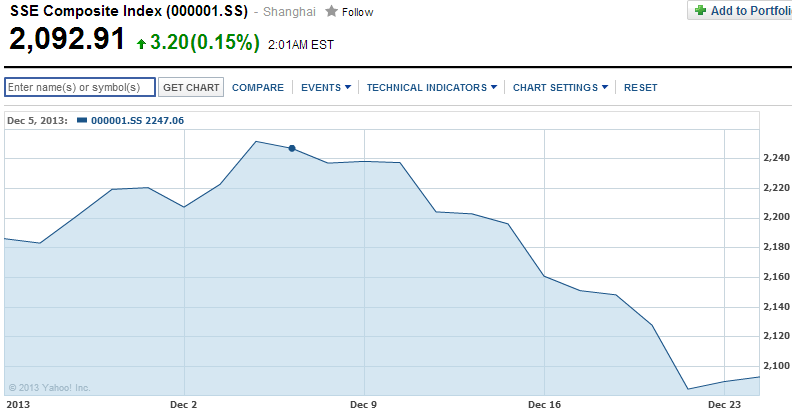China’s banks are being buffeted by the winds of change. Earlier this month, the Shanghai Composite had its longest losing streak in 19 years, which many believe was related not just to a struggling economy but also to the rise of credit in China and how this affects banks.

Banks make money by accepting deposits, paying a fairly low interest rate on those deposits, and then lending them out, and charging a comparatively higher rate of interest. The difference between those rates is the bank’s profit margin. In China, these bank interest rates have been largely regulated by the Chinese Central Bank, the People’s Bank of China (PBOC), via a benchmark interest rate.
The PBOC has traditionally imposed a collar on lending and deposit rates relative to the benchmark, with a cap on deposit rates and a floor on lending rates. This has been a great deal for Chinese banks, as it effectively creates a guaranteed spread for them. Unfortunately for all those Chinese bankers out there, the PBOC has been gradually liberalizing its rate controls by moving to a more market-driven approach.
On the lending side, the PBOC has kept a stable lower bound on bank lending rates. In early 2012, the bound was 90% of the benchmark, but was reduced to 70% later in the year. In 2013, the PBOC removed the lower limit, and introduced a new “loan prime rate” set by 9 large banks. The prospect of lower interest rates may motivate some businesses to enhance their credit profile to reap the benefits of the cheaper credit available. A more cynical view of these changes suggests that powerful state-owned businesses may strong-arm banks into making below-market loans.
On the deposit side, the PBOC has also enforced capital controls, by placing an upper bound on rates paid on deposits. The current rate is at 110% of the benchmark, although many anticipate this restriction may be eliminated in 2015 or 2016.
This may represent a far more important part of overall liberalization efforts, although these changes may still be a long way off. Chinese bank savings rates have been very low relative to inflation, and this has hurt Chinese savers and consumers who earn negative real rates on their deposits. Chinese investors have had to look elsewhere to beat inflation, including in sectors such as real estate, which contributes to a perception that China is in a real estate bubble. Any increases in interest rates on deposits would pressure bank margins, as banks would then have to compete for funding. It probably will not be a hospitable environment for Chinese bankers over the next few years.
For now, again, the most tangible aspects of liberalization have occurred on the lending side. Many argue that these changes to lending rate controls are, however, largely symbolic, since Chinese banks have not exactly raced to offer new low-interest loans. If anything, the pressure on interest rates has been upwards, not downwards. China has seen a tremendous growth in credit, which by some measures is north of 200% of GDP, and climbing, with a potentially large number of bad loans on bank balance sheets. In an effort to rein in aggressive lending, Chinese officials have curbed government spending, and attempted heavy-handed efforts to enforce greater bank lending discipline.
Last summer, seven day repo rates spiked to 12%, and the Shanghai Interbank Offered Rate (SHIBOR) also rose, as bank liquidity tightened. Clearly smaller banks were being pressured and the risk of bank defaults was rising. What surprised many is that the PBOC did not intervene by injecting liquidity stabilize the financial sector, but instead withdrew liquidity. Some have interpreted this as a signal to new, reform-minded leadership in China that vested interests in China are prepared to sacrifice smaller banks if change occurs too rapidly. Or perhaps the PBOC wanted to send a message that banks should not necessarily expect a bailout, and need to rein in their lending or face the consequences. Interpreting motives at the PBOC has always been a murky science.
Just over the past few weeks, however, interbank bank rates spiked again:
This time around, the PBOC did inject liquidity, to the tune of $4.5 billion, with plans to inject another $49 billion, which many interpret to mean that the Central Bank is much more concerned now about the smaller banks, and risks to the overall financial sector. Chinese officials have even clamped down on the media, prohibiting use of the term “cash crunch.” This may have stemmed the sharp decline in the Shanghai Composite Index:
The twin forces of credit expansion and economic liberalization are a potentially dangerous combination for China. It will be interesting to watch the drama unfold as China continues to move from its centrally-planned economy to a more economically liberal market economy.
About the Author: David Foulke
—
Important Disclosures
For informational and educational purposes only and should not be construed as specific investment, accounting, legal, or tax advice. Certain information is deemed to be reliable, but its accuracy and completeness cannot be guaranteed. Third party information may become outdated or otherwise superseded without notice. Neither the Securities and Exchange Commission (SEC) nor any other federal or state agency has approved, determined the accuracy, or confirmed the adequacy of this article.
The views and opinions expressed herein are those of the author and do not necessarily reflect the views of Alpha Architect, its affiliates or its employees. Our full disclosures are available here. Definitions of common statistics used in our analysis are available here (towards the bottom).
Join thousands of other readers and subscribe to our blog.




